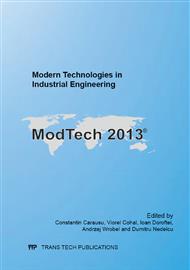p.416
p.422
p.428
p.434
p.440
p.446
p.452
p.458
p.464
Original Computer Based Solutions in Structural Studies
Abstract:
The paper is inspired by the computer based solutions developed over a period of almost 30 years. Thus, the original computer based solutions were developed for a wide range of problems: computer aided geometry for domain definition, data generators for finite element applications, output data file processors with visualization facilities, matrices defined as random access files with a wide range of subsequent applications in several disciplines and domains of science, FDM and FEM applications, customized solutions for heat transfer problems, computational fluid dynamics, experimental data reduction software applications, virtual reality facilities, semi-numeric modeling, computer based decisions. Dedicated solutions were developed for applied elasticity problems related to marine engineering problems as we as naval architecture problems: ship strength computing based on the method of initial parameters, geometrical characteristics of the cross sections, automatic calculus of the stresses of a general-shaped section and others. Most of these applications present the output data in a graphical way, in order to be more relevant for a structural analyst. Another objective was to offer not only values of different parameters, but laws of variation which may be used in other subsequent analytic studies. According to the complexity of the problem to be solved, these applications are in a range which starts at the data-crunching level up to complex and intelligent solutions, some of them being implemented in programs of tens of thousands of computer code lines. The paper presents the main features of each computer based solution, the connectivity with other solutions, the possibility to extend or adapt a given solution for a particular case study. Last but not least, there must be noticed that computer based solutions may be used in several directions of development: research, design and education..
Info:
Periodical:
Pages:
440-445
Citation:
Online since:
November 2013
Authors:
Price:
Сopyright:
© 2014 Trans Tech Publications Ltd. All Rights Reserved
Share:
Citation:


